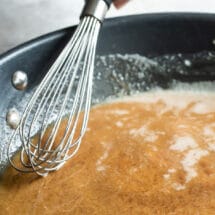
How to Make Roux
Creamy mac and cheeses, gorgeous gravies, and chowders that stick to the spoon: They all start with a roux made with fat and flour. Grab your whisk and brush up on this classic culinary technique.
Servings 4 servings
Calories 154kcal
Ingredients
- 2 ounces butter (about 1/2 stick, see note 1)
- 2 ounces all-purpose flour (about 1/2 cup, see note 2)
Instructions
- In a large heavy pot over medium heat, melt butter until foaming. Whisk in flour and cook until desired color is reached, about 1 to 5 minutes or more.
- Whisk in cold liquid to make sauce and simmer until thickened.
Notes
- Fat: Butter, clarified butter, oil, or pan drippings; some kind of fat to mix with the flour.
- Flour: All-purpose flour is most commonly used, but you can also use any flour.
- White Roux: Commonly used for white sauces, béchamel sauce, chowders, cheese sauces, or scalloped potatoes. Just cook until the flour loses its raw grain smell (about 1 minute).
- Blond Roux: Can be used for ivory-colored sauces or for a richer flavor; a good choice for gravies, stews, or broth-based sauces. Cook until the roux has a golden-brown color ( about 3 to 5 minutes).
- Brown Roux: Also known as dark roux, is a staple in Cajun and Creole recipes. Dark roux gives a deep, nutty flavor to whatever it touches. Keep cooking and whisking until the roux has a deep brown color (about 5 to 10 minutes or longer).
- Thickening power: As a roux browns, it loses its ability to thicken. Over time, the starch molecules break down. Therefore white roux has much more thickening power than a dark roux.
- Stay away from aluminum cookware: When you use a whisk, make sure the pot isn’t bare aluminum. The metal-on-metal will turn your sauce gray. Switch to a good wooden spoon instead.
- Use a heavy pot: The sturdier, the better. This will keep the flour and butter from burning.
- Stir constantly: Stirring or whisking is the key to preventing your roux from scorching. Stand by the stove the whole time, watching the pan for any hot spots that could ruin your roux.
- A little goes a long way: You certainly don’t need a lot of flour to thicken a standard recipe; usually a couple tablespoons is enough. Also, the roux doesn’t begin to show signs of thickening until the sauce just hits the boiling stage, so be patient.
- Yield: Use 3 ounces roux per 4 cups liquid for a light sauce, 4 ounces for a medium-thick sauce, and 6 ounces for a thick sauce.
- Reheating: Most traditional roux can be gently reheated when you need it.
Nutrition
Serving: 1ounce | Calories: 154kcal | Carbohydrates: 11g | Protein: 2g | Fat: 12g | Saturated Fat: 2g | Sodium: 134mg | Potassium: 15mg | Fiber: 1g | Sugar: 1g | Vitamin A: 507IU | Calcium: 4mg | Iron: 1mg